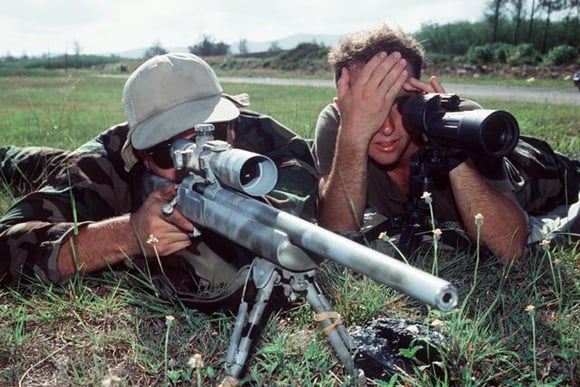This article is more than 1 year old
Computing smart-scope gunsight for US snipers
Terry Pratchett gizmo makes long shots hit 6 times out of 10
First breadboard, then brassboard. Then it's ready for the brass hats to see it
But in general, even powerful sniper rifles like Harrison's L115A3 Long Range Rifle (aka the Arctic Warfare Super Magnum** from Accuracy International) aren't expected to achieve a first-shot kill further off than 600m, and "harassing fire" to 1100m. In particular, the estimation of crosswinds between the shooter and the target is usually a matter of educated guesswork. Then, making the right corrections for range, height, bullet spin, temperature, air pressure etc can take so long that the target has moved away before the sniper can shoot.
But it seems that there's no need for this to be the case. US military trials have found that a laser beam shone on the target can do more than just determine the range: it can also be used to "measure the average down range crosswind profile". The laser information can be combined with automatic readings of temperature, humidity etc and a "ballistic solution" computed.
Then a set of artificial crosshairs can be generated in the rifle showing where the bullet will actually strike. These can then be moved onto the target. Alongside the crosshairs is a constantly updated readout of how reliable the calculated aim point is and how likely it is to shift during the time the bullet is in flight (perhaps several seconds at long ranges). This lets the sniper choose the right time to shoot.

That spotting scope is ridiculously old-fashioned. Let's pimp that baby up some.
Such equipment has been tried out by US snipers working with a "brassboard" prototype setup (that is, one a bit more developed than a breadboard rig, but still not ready for actual field use). According to the "One Shot" project's managers:
The brass-board system was tested by trained snipers and designated marksmen under varying environmental conditions up to 1100 meters and 5-8 m/s average crosswinds. The brassboard system demonstrated a marked capability as compared to current sniper system. Under all test conditions, the brassboard system significantly improved the first round hit probability, required fewer rounds, and less time to get the first hit vs users without the One Shot system.
Now the idea is to integrate the brassboard equipment into a special nightsight/thermal/optical telescope instrument to replace the one carried by the sniper team's spotter, linked either wirelessly or by a cable to a display widget attached to the scope on the sniper's rifle. The new smartscope will hold the various lasers, instruments and calculating hardware necessary to generate the virtual crosshairs in the gunsight display.
